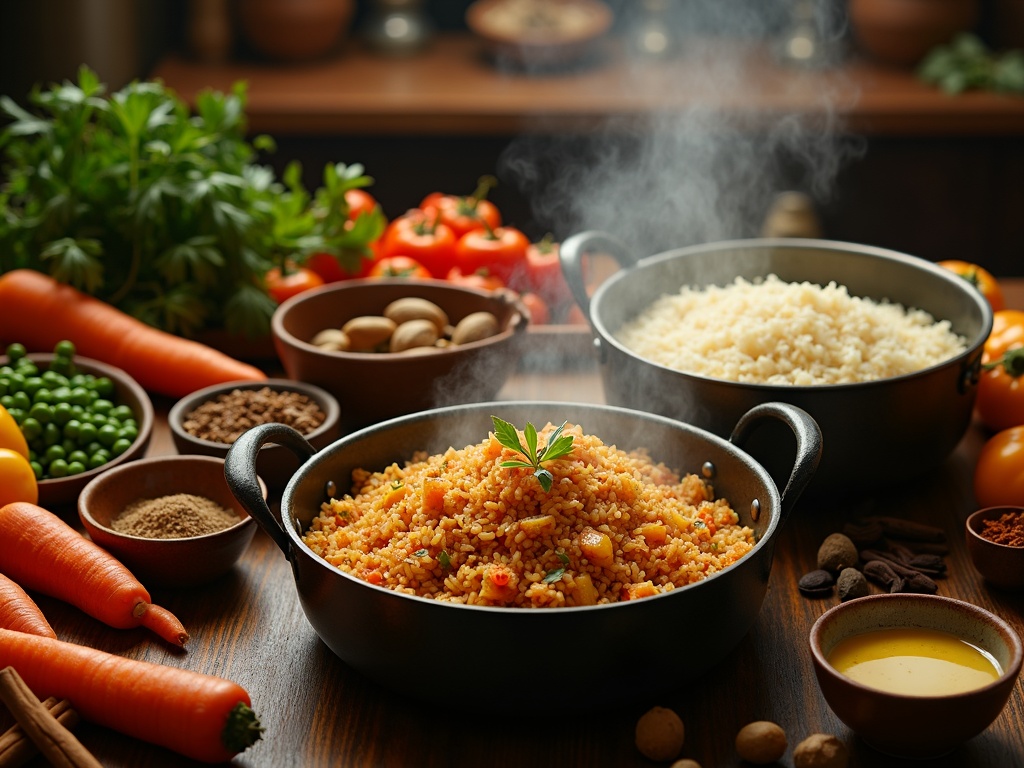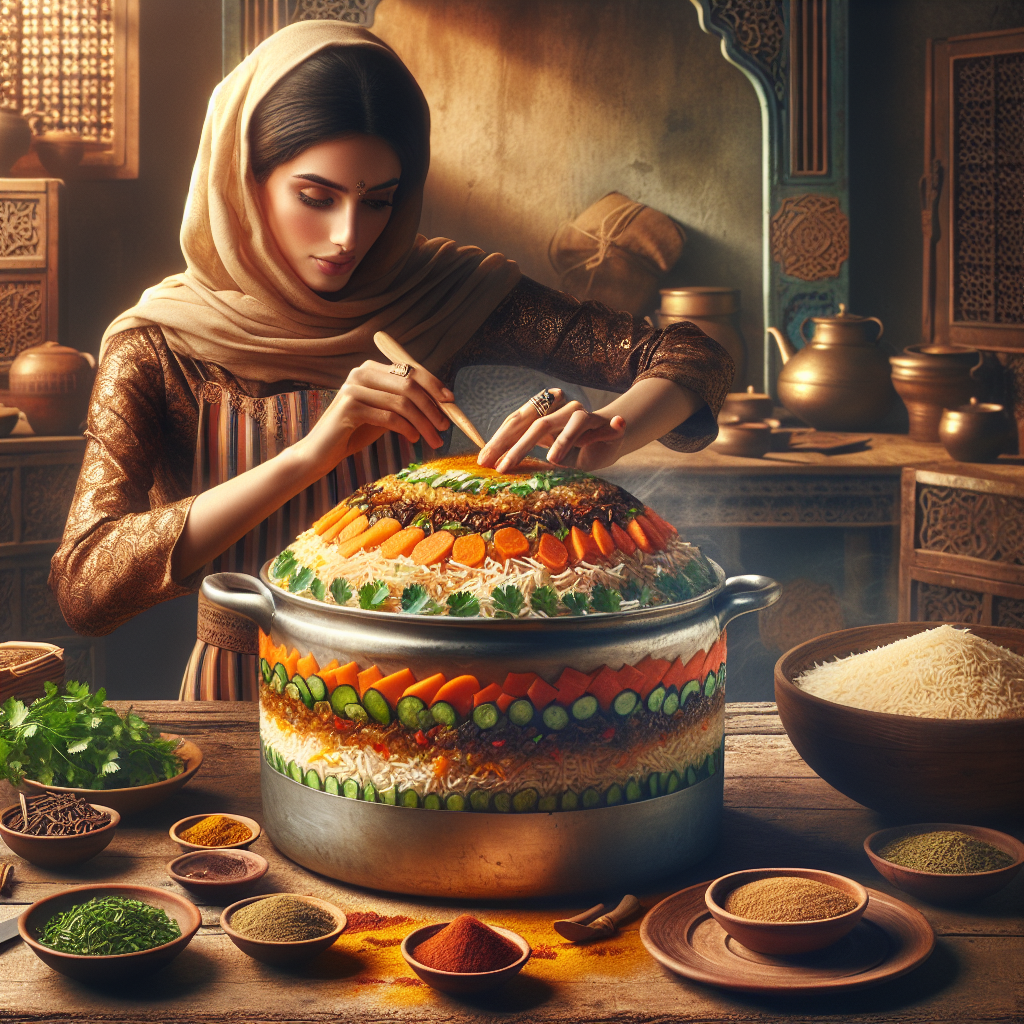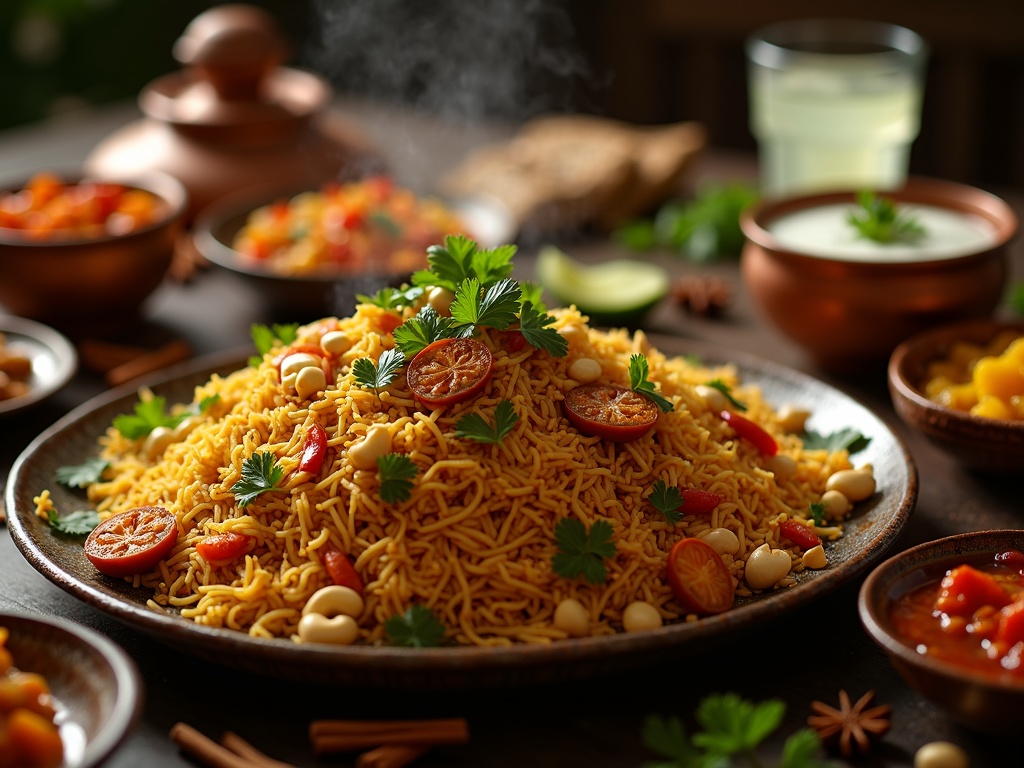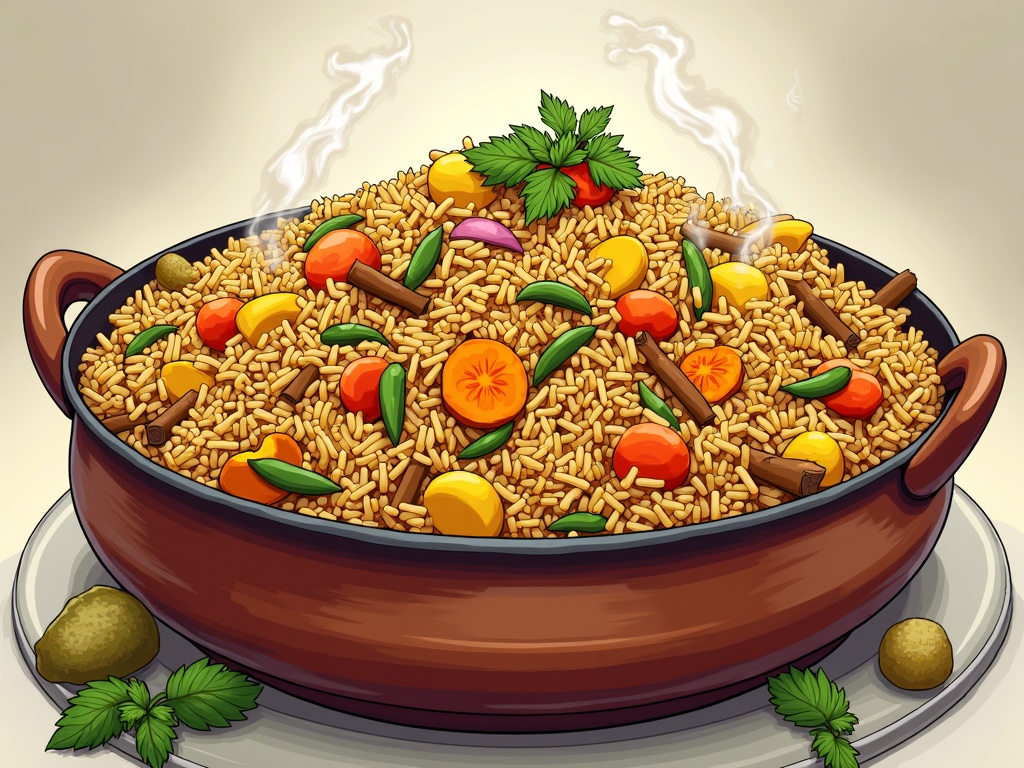Veg biryani recipe combines aromatic basmati rice with colorful vegetables and a perfect blend of spices. This fragrant Indian rice dish comes together through specific layering techniques and the traditional “dum” cooking method that locks in steam, infusing each rice grain with deep flavors while maintaining ideal texture.
Key Takeaways
- Aged basmati rice soaked for 30 minutes creates the foundation for perfect, non-sticky biryani with distinct grains.
- The aromatic base requires whole spices (cardamom, cloves, cinnamon, bay leaf) and ground spices (cumin, coriander, turmeric, garam masala).
- Proper layering technique alternates partially cooked rice with spiced vegetables, fresh herbs, and garnishes.
- The “dum” cooking method involves sealing the pot tightly and cooking on low heat for 20-25 minutes without opening.
- Serving with cooling raita, crispy fried onions, and toasted nuts provides the perfect balance of flavors and textures.
I’ve found that using aged basmati rice makes a significant difference in the final dish. The long soak time allows each grain to absorb just enough moisture before cooking, resulting in fluffy, separate grains rather than a mushy texture.
The spice combination creates that signature biryani aroma. Whole spices toast in hot oil, releasing their essential oils before adding the ground spices that coat each vegetable with their rich flavor compounds.
Layering is an essential technique. I start with a base of spiced vegetables, then add partially cooked rice, followed by fresh herbs and repeat. This ensures even distribution of flavors throughout the pot.
The sealed cooking process is critical. I place a tight-fitting lid on the pot and sometimes add weight or seal with dough to trap all steam inside. The slow, steady heat then works its magic without any peeking!
The final presentation benefits from contrasting elements. Cool yogurt raita balances the warm spices, while crispy onions and toasted nuts add textural interest to each bite.
What You’ll Need for a Perfect Veg Biryani Recipe
I’ve found that creating an authentic vegetable biryani requires a perfect balance of premium ingredients. The right components make all the difference between an ordinary rice dish and an extraordinary biryani experience. Let me walk you through everything you’ll need to create this aromatic masterpiece.
Essential Ingredients for Your Biryani
The foundation of any good biryani starts with high-quality rice. I recommend using 2 cups of aged basmati rice, which creates a better texture with distinct, fluffy grains that don’t stick together. Soaking the rice for 30 minutes before cooking helps achieve that perfect non-sticky consistency.
For vegetables, you’ll need about 1.5 cups of mixed veggies. I typically use a colorful combination of:
- Carrots (cut into small cubes)
- Green peas (fresh or frozen)
- French beans (chopped into small pieces)
- Potatoes (diced into medium-sized cubes)
The magic of veg biryani lies in its aromatic spices. You’ll need whole spices including:
- 2-3 green cardamoms
- 3-4 cloves
- 1-inch cinnamon stick
- 1 bay leaf
These whole spices should be tempered in hot ghee or oil to release their essential oils and fragrances.
For ground spices, gather:
- 1 teaspoon cumin powder
- 1 teaspoon coriander powder
- ½ teaspoon turmeric powder
- 1-2 teaspoons garam masala (adjust according to your spice preference)
Fresh ingredients add brightness and depth to your biryani:
- ½ cup mixed cilantro and mint leaves, finely chopped
- 1 large onion, thinly sliced (these will be fried until golden brown)
- 1 teaspoon ginger-garlic paste (freshly made works best)
The base components that bring everything together include:
- ½ cup plain yogurt (this tenderizes the vegetables and adds tanginess)
- 3-4 tablespoons ghee or oil (ghee adds authentic flavor)
- Salt to taste
- 4 cups water for cooking the rice and creating the final dish
I’ve found that layering is key to creating an authentic dum biryani. The process involves partially cooking the rice, preparing the vegetable gravy separately, then layering them together with fresh herbs before slow-cooking on low heat.
The yogurt creates a rich, creamy base for the vegetables while adding a subtle tanginess that balances the warm spices. For extra richness, you can add a few tablespoons of fried onions between the layers.
Remember that the quality of your ingredients significantly impacts the final flavor. Using aged basmati rice makes a noticeable difference, as does using fresh herbs rather than dried ones. The ghee, while optional if you prefer a lighter version with oil, adds that authentic richness that makes restaurant-style biryani so irresistible.
These ingredients come together to create a fragrant, flavorful veg biryani that’s perfect for special occasions or weekend family meals. The beauty of this dish lies in how these simple ingredients transform into a complex, layered experience of textures and flavors that delight the senses.
Mastering the Preparation Method
The journey to a perfect vegetable biryani begins with proper preparation. I’ve found that mastering these initial steps makes all the difference between an ordinary rice dish and an extraordinary vegetable biryani that dazzles the senses.
Preparing the Foundation
First, I always soak basmati rice for exactly 30 minutes. This step is non-negotiable as it allows for proper grain elongation when cooking. The soaking process helps the rice grains develop that distinct fluffy texture that’s characteristic of an authentic veg biryani. While the rice soaks, I gather and prep all my vegetables and spices – organization is key for seamless cooking.
Once my rice is soaking, I heat ghee or oil in a heavy-bottomed pan. The fat needs to be hot but not smoking before adding sliced onions. I sauté them patiently until they reach that perfect golden-brown color – this typically takes about 8-10 minutes. These caramelized onions create the **flavor foundation** for the entire dish, lending sweetness and depth.
Next comes the aromatic base. I add ginger-garlic paste and cook it for 2 minutes, stirring constantly. This short cooking time is enough to remove the raw aroma while preserving the essential flavors. Skipping this step often results in an unpleasant raw taste in the final dish.
Building Layers of Flavor
The spice sequence matters significantly when creating an authentic dum biryani flavor. I first add whole spices – cinnamon sticks, cardamom pods, cloves, and bay leaves – allowing them to release their oils into the ghee. After 30 seconds, when the kitchen fills with their aroma, I incorporate ground spices like turmeric, red chili powder, and garam masala.
Now comes the vegetable preparation. I add my prepped vegetables to the spice mixture and sauté them for 5-7 minutes. This partial cooking is strategic – it ensures the vegetables will be **perfectly tender** when the biryani finishes cooking. I make sure not to overcook them at this stage, as they’ll continue cooking with the rice later.
The final preparation step involves yogurt, which adds creaminess and tanginess while tenderizing everything. I stir in plain yogurt and cook for 2-3 minutes until it’s well incorporated with the vegetables and spices. This brief cooking prevents the yogurt from separating and creates a harmonious base for the rice to absorb.
Here’s a quick breakdown of the key preparation points to remember:
- Always use a timer when soaking rice (30 minutes precisely)
- Achieve true golden-brown onions (not just translucent)
- Cook ginger-garlic paste thoroughly but briefly
- Follow the correct spice addition sequence
- Partially cook vegetables to the right stage
- Incorporate yogurt properly without curdling
The preparation method I’ve outlined creates the **perfect foundation** for layering with rice. These steps might seem detailed, but they’re what separate a basic rice dish from a **memorable biryani experience**. The time invested in proper preparation pays off with a complex flavor profile that simply can’t be achieved with shortcuts.

The Art of Layering and Cooking
Perfecting a delicious veg biryani depends heavily on the layering technique and cooking method. I’ve found that these steps truly transform simple ingredients into a fragrant, flavor-packed dish that delights everyone at the table.
Creating Perfect Layers
Layering isn’t just about stacking ingredients—it’s about creating flavor harmony. I start with a base layer of the vegetable mixture at the bottom of a heavy-bottomed pot. This foundation of spiced vegetables forms the flavor base for the entire dish.
Next comes a layer of partially cooked rice (about 70% done), followed by another layer of vegetables. Each time I add a new layer, I sprinkle garam masala, chopped mint, and coriander leaves. These aromatic additions between layers ensure the flavors penetrate every grain of rice.
For the most authentic taste, I continue alternating layers until all ingredients are used, finishing with a final layer of rice. This method ensures that every serving contains the perfect balance of spiced vegetables and fragrant rice.
The secret to a great layered vegetable biryani is proper proportion. I typically use 4 cups of water for every 2 cups of rice, which creates the perfect texture—not too dry or soggy.
Mastering the Cooking Technique
The cooking method makes or breaks your biryani. After layering, I seal the pot tightly to trap all the steam and flavors inside. For a traditional approach, I create a dough seal (called “dum“) by mixing flour and water into a rope that’s placed around the lid’s edge. This ancient technique prevents any steam from escaping.
I cook the biryani on low heat for 20-25 minutes. The slow cooking allows the flavors to meld beautifully while ensuring the rice cooks evenly without becoming mushy. The pot should never be opened during this time—patience is key!
For a modern twist, I sometimes use oven cooking for a dum biryani approach. After completing the layering, I cover the pot with foil and then place the lid on top. I bake it at 350°F (175°C) for about 20 minutes. This method provides even heat distribution and works exceptionally well.
Once cooking is complete, I resist the temptation to serve immediately. Instead, I let the biryani rest for 10 minutes with the lid still on. This resting period allows the flavors to settle and the excess moisture to be absorbed by the rice.
When serving, I use a large spoon to scoop from bottom to top, ensuring each portion contains all the delicious layers. The perfect biryani should have distinct grains of rice that are infused with flavor but still maintain their individual texture.
The cooking technique might seem particular, but it’s these details that make the difference between a good biryani and an unforgettable one. The steam trapped inside the pot carries flavors between layers, creating a dish where every bite tells a story of carefully balanced spices and textures.

Perfect Pairings and Presentation
The magic of veg biryani extends beyond the dish itself – how you serve and pair it can transform your dining experience. I’ve found that the right accompaniments enhance the flavors while creating a balanced meal that delights all the senses.
Complementary Side Dishes and Garnishes
A cooling raita is the perfect counterbalance to the aromatic spices in biryani. I mix thick yogurt with finely diced cucumber, chopped mint leaves, and a pinch of roasted cumin powder. This refreshing side dish cools the palate between bites of spicy vegetable biryani, creating a harmonious taste experience.
The presentation of biryani matters just as much as its preparation. Before serving, I garnish my biryani with:
- Fresh cilantro and mint leaves for bright, fresh flavor
- Crispy fried onions that add textural contrast
- A sprinkle of toasted cashews or almonds for nuttiness
- A few strands of saffron for visual appeal and aroma
For a complete meal, pair your biryani with a spicy vegetable curry or tangy pickle. The heat from the curry or the tanginess of the pickle cuts through the richness of the biryani rice. I particularly enjoy serving my dum biryani with a side of spicy brinjal curry or mixed vegetable salan.
Traditional serving calls for presenting biryani in a large, communal dish. This family-style presentation encourages sharing and conversation. For special occasions, I serve biryani in a clay pot or decorative copper handi, which keeps it warm throughout the meal while adding an authentic touch.
I’ve noticed that serving temperature makes a big difference too. Biryani tastes best when served hot, straight from the pot. The steam carries the aromatic spices directly to your nose, enhancing the overall sensory experience.
For those tracking nutritional intake, a cup of vegetable biryani provides approximately 330 calories. It offers a balanced nutritional profile with 9g of protein, 60g of carbohydrates (including 4g of fiber), and 10g of fat. The colorful vegetables in the biryani contribute significant Vitamin A and various antioxidants that support overall health.
The protein content makes this dish relatively satisfying, while the fiber helps with digestion and provides a feeling of fullness. The moderate fat content comes primarily from the cooking oil and any nuts used in garnishing.
I’ve found that timing matters when serving the accompanying dishes. Raita should be chilled before serving, while curries should be warm. This temperature contrast adds another dimension to the meal. For beverages, a simple glass of chilled lassi or even just plain water works perfectly with the complex flavors of biryani.
Don’t forget the power of aroma in presentation. I sometimes place a few whole spices like cinnamon sticks or star anise on top of the biryani just before serving. When the lid is removed at the table, these spices release their fragrance, creating an impressive sensory moment for your guests.

Pro Tips for Biryani Success
I’ve been making veg biryani for years, and I’ve learned that little details make a huge difference. These pro tips will elevate your biryani from good to spectacular, impressing even the most discerning guests.
Ingredient Selection and Preparation
The foundation of any amazing vegetable biryani starts with quality ingredients. Aged basmati rice is non-negotiable for authentic biryani. This longer-grain variety has been dried for at least a year, giving it a distinct aroma and helping it maintain its shape during the cooking process. The grains stay separate rather than clumping together, creating that perfect biryani texture.
Seasonal vegetables bring brighter flavors to your dish. Summer calls for bell peppers, green beans, and carrots, while autumn offers cauliflower, peas, and potatoes. These seasonal choices contribute fresher taste and better nutritional value compared to out-of-season alternatives.
Getting the rice-to-water ratio right is crucial for perfect biryani. For soaked rice (which I highly recommend), maintain a 1:1.5 ratio of rice to water. Soaking the rice for 30 minutes before cooking softens the grains and ensures even cooking.
The signature tenderness of dum biryani comes from proper steam retention. I create a tight seal using a heavy lid with dough around the edges. This “dum” cooking method traps steam, allowing flavors to meld while cooking the rice perfectly. If you don’t have dough handy, use aluminum foil wrapped tightly around the lid’s edges.
The layering technique distributes flavor evenly throughout the dish. Start with a base of aromatic gravy, then add half-cooked rice, followed by more gravy and vegetables. Continue alternating until you’ve used all ingredients, finishing with a rice layer. This method ensures every bite contains the full spectrum of biryani flavors.
By focusing on these key aspects of biryani preparation, you’ll create a dish that’s fragrant, flavorful, and perfectly cooked every time.
Sources:
Traditional Indian Cooking by Greg Malouf
The Joy of Cooking: Indian Vegetarian by Radha K. Seth
Biryani: A Cookbook by Nishat Zaman
Nutritional Facts of Popular Indian Dishes – Healthline Article

